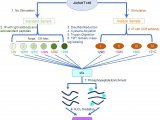
The T cell receptor is a cell-surface receptor that recognizes specific antigen to stimulate the T cell response to that antigen. The T cell receptor complex of transmembrane proteins includes the T cell receptor that recognizes antigen and a set of proteins called CD3 involved in signal transduction. CD3 associated with the T cell receptor includes six polypeptides arranged in three dimers that recruit and activate protein kinases to signal the activation of T cell receptor by bound antigen through recruitment and activation of protein kinases (see T Cell Receptor Signaling Pathway). T cell receptors only recognize antigen on the surface of other cells, not antigen in solution, by requiring antigen to be bound to MHC proteins on the surface of other cells to be recognized. Cytotoxic T cells recognize antigen bound to MHC I on the surface of other cells and helper T cells recognize antigen bound to MHC II on antigen-presenting cells. CD4 (helper T cells) and CD8 (cytotoxic T cells) are cofactors in MHC recognition. Recombination in immature T cells of the genes for the alpha and beta T cell receptor subunits creates a huge variety of variable regions involved in antigen recognition resulting in many antigen specificities in the population of immature T cells. Some T cells called gamma/delta cells express T cell receptor composed of gamma and delta subunits rather than alpha/beta subunits. When the T cell receptor on a cell interacts with antigen in the proper context, that cell is stimulated to become activated and proliferate, in a process known as clonal selection. The recombination of T cell receptor genes and clonal selection of cells that bind specific antigen is very similar to the B cell process that creates immunoglobulins and clonal selection of B cells that bind antigen.
Contributor: Glenn Croston, PhD


